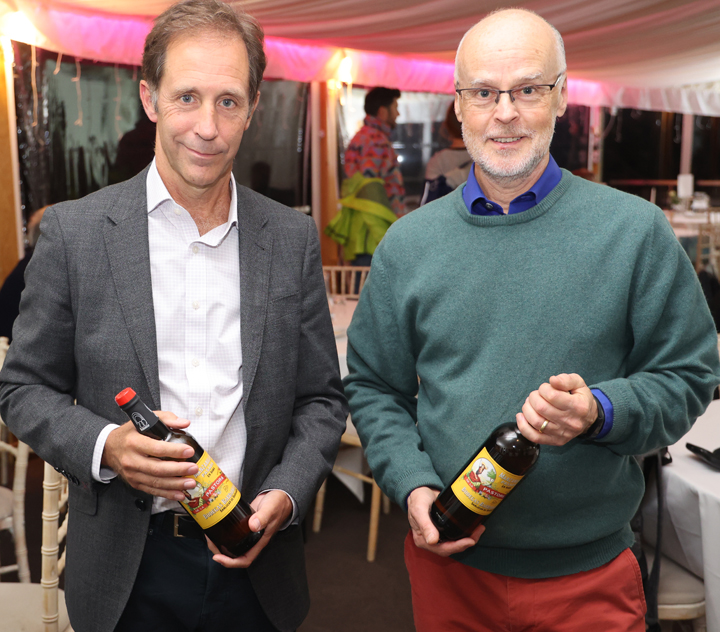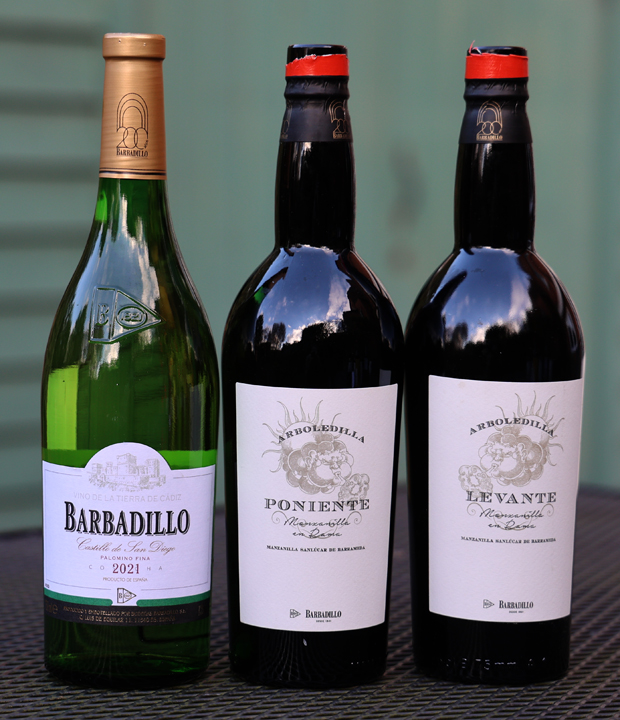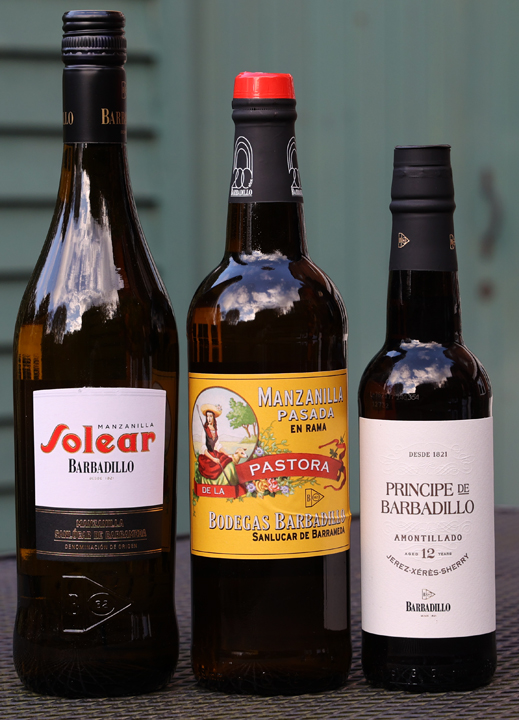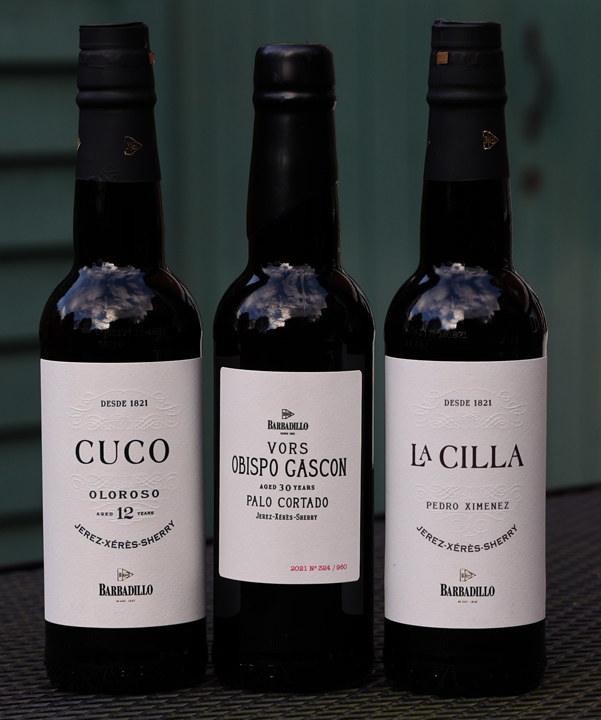 Tim Holt of Barbadillo treated OWC members and guests to a fascinating and informative master class on the production of sherry, accompanied by a tasting of 9 differing Barbadillo wines.
Tim Holt of Barbadillo treated OWC members and guests to a fascinating and informative master class on the production of sherry, accompanied by a tasting of 9 differing Barbadillo wines.
Background
The term sherry is used for series of traditional fortified wines, produced in an area in the province of Andalucia, in the south of Spain. The denomination of origin is one of the oldest in Spain. The production area traditionally consisted of the so-called sherry triangle. This is formed by the cities Jerez de la Frontera, Sanlúcar de Barrameda (also known as the gastronomic capital of Spain) and El Puerto de Santa María, plus six neighbouring municipalities. The soil in this region is chalk / limestone based. It provides the perfect conditions for growing Palomino, Pedro Ximénez and Moscatel, the three traditional grape varieties used in the production of sherry, since it retains the winter rainfall, which is vital since under the denomination of origin rules no irrigation is allowed.
The climate in the area is Mediterranean, with mild wet winters and hot dry summers.
Barbadillo’s history dates back to 1821; the year in which they first began producing Manzanilla wine. With vineyards that stretch over 500 hectares, 16 ageing wineries in Sanlúcar de Barrameda, and a red and white winemaking plant, Barbadillo is one of the largest wineries in the Marco de Jerez vineyard area.
Bodegas Barbadillo has a very close association with Manzanilla, being the first company to ever name a sherry Manzanilla, the first to sell it in bottle as opposed to the barrels, and one that is still the world’s leading producer of Manzanilla. Manzanilla Solear is Barbadillo’s flagship brand.
As well as sherry, Barbadillo produces and sells a wide range of products including, gin, brandy, red and white wines and vinegars. Barbadillo is the producer of the Barbadillo ‘Castillo’ white wine which is the best-selling white table wine in Spain.
Bodegas - bodegas, where sherries are matured, are unlike a traditional winery, with bodegas being more open and airy due to sherry’s appetite for oxygen. Bodegas Barbadillo owns 16 bodegas that are dotted throughout the best sites, in Sanlúcar de Barrameda and collectively house 32,000 casks. The Barbadillo bodegas are located on elevated ground called the ‘high quarter’ of the town next to the Guadalquivir River, facing out towards the Atlantic Ocean. They have been built here for more than just stunning views during the ageing process – their position and design make them perfect for trapping the sea breeze, which brings lots of humidity, keeps the air cool in the summer and is also believed to give sherry its characteristic salty tang.
Manzanilla – Manzanilla can only be made in Sanlúcar due to its specific microclimate. If it’s 40 degrees in Jerez in summer, Holt estimated it will be down in the 30s in Sanlúcar. This microclimate has been utilised for centuries as part of sherry production.
Flor - Tim reminded those present that flor is the veil or thin layer of indigenous yeast cells that forms on top of biologically aged sherry wines. It is a kind of Ivory coloured, wrinkled, waxy foam, up to two centimeters thick, that protects the wine from air contact and that grows naturally in the specific microclimate of Southern Spain.
Until the late 18th century sherry wines were mostly vintage wines, brown (oxidative) and heavily fortified. Flor occured naturally but it was seen as a defect, a variation on Mycoderma Vini which makes wine cloudy and smelly. It wasn’t until the 1820s that Manzanilla and Fino as we know them today are produced under the influence of flor, although the mechanisms behind this phenomenon remained unknown for many years.
Flor basically divides all of the sherry denomination wines into two main categories: biologically aged sherry (the ‘natural’ way– wines that mature entirely under this layer of flor – Manzanilla and Fino) and oxidative sherry (which matures in contact with oxygen Olorosa and Pedro Ximénex)
Tim told us that flor is a very delicate organism. If it gets too dry, too hot, or too cold it will die off. It will also become very unhappy if it’s in a closed atmosphere. It doesn’t want a dank atmosphere, it wants a breezy, well-aerated area in which to thrive because it is highly aerobic. Hence the use of bodegas.
Production Process - Tim reminded us of the production process that sherries go through, following production of the base wines. After filtering the musts, correcting the pH and treatment with sulphur dioxide to prevent bacterial contamination, the grape juices will start to ferment naturally. (At Barbadillo they claim no sulphur is used due to the hyper oxygenated must.) In the old days this was done in wooden barrels but nowadays most bodegas use huge stainless steel tanks that are heated to 23-25°C. Usually a small amount of already fermenting must (pie de cuba) will be added to speed up the initial process. At Barbadillo most of the yeasts are wild indigenous yeasts. Different natural yeasts occur in Jerez and Sanlúcar. After that, two phases of fermentation (tumultuous and slow fermentation) take place.
Musts of Palomino grapes will keep fermenting until nearly all of the available sugars are processed into alcohol – this will lead to a “base wine”. The other sweet musts of PX and Moscatel will be brought to 10% alcohol very early in the process, in order to retain a lot of the sugars. The wine is left to settle and slowly ferment during the winter months. It is then fortified to its final strength of 15-18%.
At the end of the fermentation process, a layer of flor will naturally occur on these base wines.
After fermentation the lees will be filtered off and the musts will be classified. The finest, most delicate examples will be fortified to 15 – 15,4% vol. alcohol by adding neutral grape spirit. The delicate musts are intended for biological ageing, i.e. ageing under a layer of flor, without contact to oxygen.
The slightly coarser base wines, which show less elegancy at this stage, will be fortified to 17 – 18% vol. alcohol. This kills any existing flor. From that moment, the wine will mature in an oxidative way, with contact to the surrounding air. The result will be an Oloroso. Naturally sweet wines will always be fortified to a higher degree as flor is not wanted in this type of sherry.
After the first fortification and a short maturation, the base wines or sobretablas will be classified again. The different categories will then enter a solera, an array of barrels that are arranged in a hierarchical way, with the younger wines partially replacing the older wines that are taking out.
In accordance with the regulations of the Denomination of Origin the ageing of sherry wines must last at least two years (this used to be three years), enough time to allow the wines to develop the distinctive characteristics of each type.
Nowadays the preferred type of cask is the American oak 600 litre butt, also known as a bodega butt. It is never filled to the top, thus creating a surface area upon which the flor may develop. Some of Barbadillo’s oak casks are over 100 years old.
Soleras - Barrels in a solera are arranged in different groups or tiers, called criaderas or nurseries. Each scale contains wine of the same age. The oldest scale, confusingly called solera as well, holds the wine ready to be bottled. When a fraction of the wine is extracted from the solera (this process is called the saca), it will be replaced with the same amount of wine from the first criadera, that is the one that is slightly younger and typically less complex. This, in turn, will be filled up with wine from the second criadera and so on. The last criadera, which holds the youngest wine, is topped up with the wine from the latest harvest, named sobretabla. Taking away part of the wine and replacing it with the contents of other scales, is called rociar or to wash down.
The wines
 1. Barbadillo ‘Castillo’ Palomino 2021 – made from the Palomino grape, and 90% machine harvested, grapes are processed on the stem and a continuous helix screw press is used. This was the first white wine to be made in Andalucia and has its own website www.castillodesandiego.com. Pale straw in colour with a delicate nose hinting at white flowers. On the palate crisp, delicate, smooth and dry with hint of apples and pears.
1. Barbadillo ‘Castillo’ Palomino 2021 – made from the Palomino grape, and 90% machine harvested, grapes are processed on the stem and a continuous helix screw press is used. This was the first white wine to be made in Andalucia and has its own website www.castillodesandiego.com. Pale straw in colour with a delicate nose hinting at white flowers. On the palate crisp, delicate, smooth and dry with hint of apples and pears.
Next we experienced two cask sample Manzanillas, illustrating the impact of the ageing process on the wines and the influence of the sea breezes on the wines. Both wines were the same age and came from La Arbodedilla, the ‘Cathedral’ Bodega, which was purpose build in 1870.
2. Cask Sample No 1 –a more pronounced woody, nutty nose and from the more enclosed end of the bodga
3. Cask Sample No 2 – from the ‘sea’ end of the bodega and showing more of the Manzanilla ‘salty’ tang on the nose and palate than sample 1.
 4. Manzanilla Solear – this is Barbadillo’s flagship brand, distinctly lighter in colour than the cask samples due to the ageing process. Clean, bright and pale yellow colour. A somewhat intense nose, with some finesse originating from the prolonged contact with the flor. Delicate hints of salty air and camomile. Very dry on the palate but then smooth on the finish. Subtle, slightly salty and with a persistent and pleasing flavour. Tim recommended drinking the wine with seafoods, cured ham and indeed any salty foods.
4. Manzanilla Solear – this is Barbadillo’s flagship brand, distinctly lighter in colour than the cask samples due to the ageing process. Clean, bright and pale yellow colour. A somewhat intense nose, with some finesse originating from the prolonged contact with the flor. Delicate hints of salty air and camomile. Very dry on the palate but then smooth on the finish. Subtle, slightly salty and with a persistent and pleasing flavour. Tim recommended drinking the wine with seafoods, cured ham and indeed any salty foods.
5. Manzanilla Pasada Pastora. This wine spends a further two stages in the solera system, with the solera process taking place twice a year. Whereas the Solear goes through nine stages over six years, the last two years for Pastora take a slower pace, leading to a thinning of the flor layer which allows a little oxidation.
The end result is a golden sherry with more pronounced chamomile notes. It is a step up in complexity, with a bigger body, a richer, more oily texture and a slight nuttiness on the palate. The bodega’s Manzanilla Pasadas are all en rama (unfiltered), the way they would have been made a hundred years ago. In fact, Bodegas Barbadillo was the first to pioneer en rama as a modern category in 1999 with four ‘sacas’ (or releases) coming every year so that you can see the influence of the seasons.
6. Amontillado Principe 12 yr. This has a further four years ageing than the Pasada Manzanilla. On the nose lots of nuts and toffee. A very dry palate, with pronounced hazelnut flavours. Amontillados are firstly aged biologically as a Manzanilla, under flor, for 8 years before a further 7 years of oxidative ageing.
 7. Oloroso Cuco 12 yr. (Cream sherry is the sweet version of Oloroso.) Once the fermentation of the Palomino must has finished, the most robust wines are selected and fortified with wine-based distilled spirit to bring the alcohol content up to 18%. This fortified wine is known as sobretablas and is destined for ageing in traditional Jerez butts, usually of 500 litre capacity. The ageing or crianza is achieved through oxidation of the wine whilst in barrel and racking within each tier of the criadera. Mahogany in colour and with oak, dried fruits and nuts on both the nose and palate. Smooth and dry.
7. Oloroso Cuco 12 yr. (Cream sherry is the sweet version of Oloroso.) Once the fermentation of the Palomino must has finished, the most robust wines are selected and fortified with wine-based distilled spirit to bring the alcohol content up to 18%. This fortified wine is known as sobretablas and is destined for ageing in traditional Jerez butts, usually of 500 litre capacity. The ageing or crianza is achieved through oxidation of the wine whilst in barrel and racking within each tier of the criadera. Mahogany in colour and with oak, dried fruits and nuts on both the nose and palate. Smooth and dry.
8. Palo Cortado VORS Obispo Gascon. This a rare type of sherry and production is limited (only 240 bottles were produced in 2020 by Barbadillo). The name derives from the chalk signs made on the barrels (palo: stick, cortado: short). The VORS designation (Vinum Optimum Rare Signatum) under the denomination rules mean that the wine must be aged for over 30 years. Tim told us that Barbadillo’s method is to have certain select-cask Oloroso that originates from free-run juice, and therefore has a much finer style than the normal second press Oloroso. There is also a matter of chance. Each cask can be slightly different depending on its origins and position in the bodega. The idea of a Palo Cortado is that you’re trying to get the best of an Amontillado in terms of aroma, and the best of Oloroso in terms of body, mouth feel and flavour. Amber in colour, on the nose and palate, intense with lots of nuts, dried fruits and dried orange peel.
9. Pedro Ximénez La Cilla. PX sherries are naturally sweet dessert wines created from the grape variety with the same name. The grape is a white one, but the resulting sherry is almost black in colour. In order to use the Pedro Ximénez name, the wine has to contain at least 85% of Pedro Ximénez grapes. The grapes are either picked very ripe and/or dried in the sun to concentrate (a process called asoleo). The Pedro Ximénez grape variety is believed to have been introduced to Spain by a German soldier, Pieter Siemens, although this story is debated. Once the grapes have been pressed, the must is fortified with a wine-based distilled spirit to bring the alcohol content up to 17.5%. It is then matured in American oak barrels following the traditional system of soleras and criaderas. Dark mahogany in colour and with plums, raisins and chocolate on both the nose and palate.
HRE 10.11.22